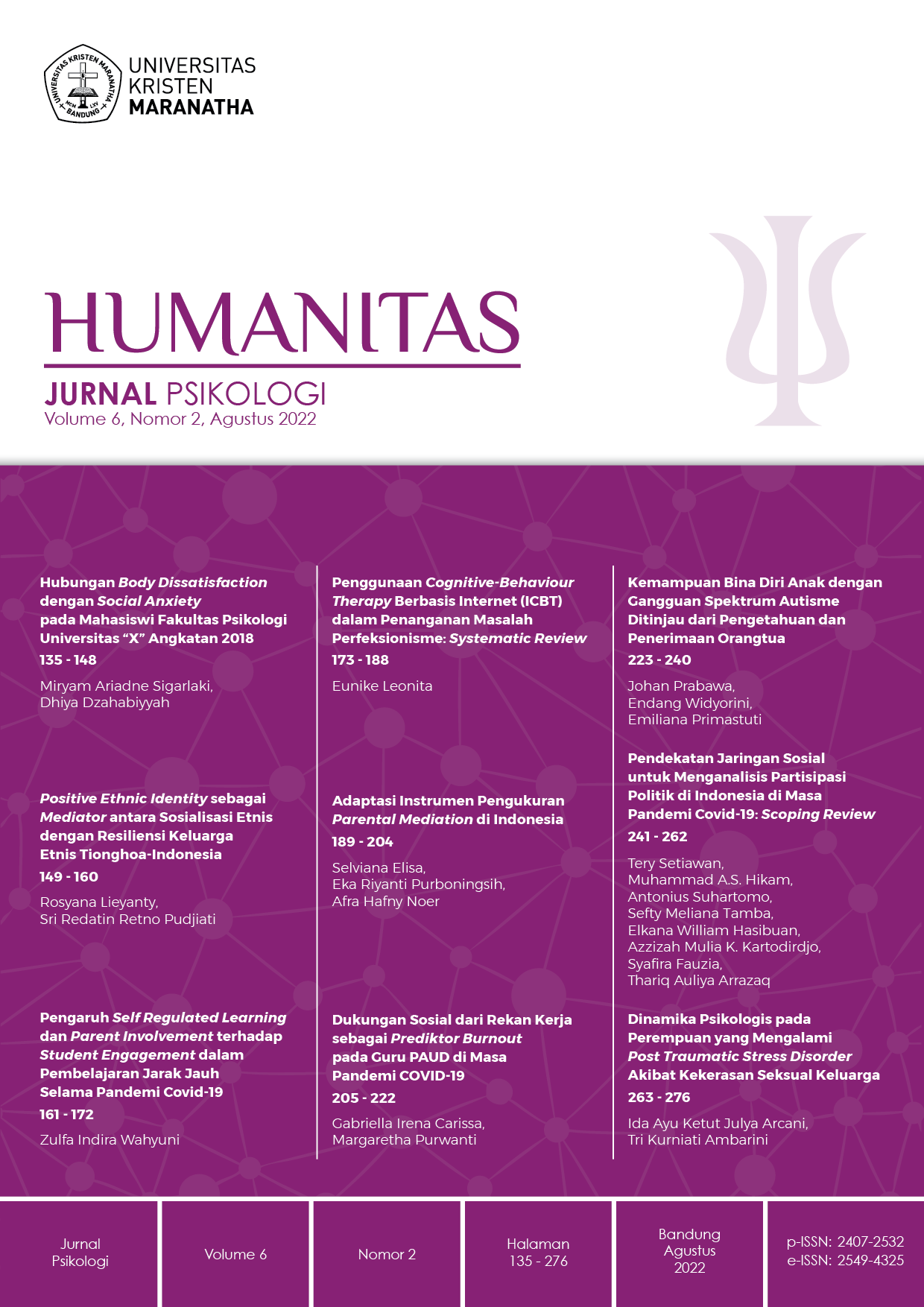Adaptasi Instrumen Pengukuran Parental Mediation di Indonesia
Isi Artikel Utama
Abstrak
Unduhan
Rincian Artikel

Artikel ini berlisensi Creative Commons Attribution-NonCommercial 4.0 International License.
Referensi
Chen, V., & Chng, G. S. (2016). Active and restrictive parental mediation over time: Effects on youths’ self-regulatory competencies and impulsivity. Computers and Education, 98, 206–212. https://doi.org/10.1016/j.compedu.2016.03.012
Chen, L., & Shi, J. (2018). Reducing Harm From Media: A Meta-Analysis of Parental Mediation. Journalism and Mass Communication Quarterly, 96(1), 173–193. https://doi.org/10.1177/1077699018754908
Clark, L. S. (2011). Parental mediation theory for the digital age. Communication Theory, 21(4), 323–343. https://doi.org/10.1111/j.1468-2885.2011.01391.x
Creswell, J. W. (2009). Research Design: Qualitative, Quantitative and Mixed Methods Approaches. In Muqarnas (Vol. 8). SAGE Publications, Inc. https://doi.org/10.2307/1523157
D.F. Polit; C.T. Beck. (2006). The Content Validity Index: Are You Sure You Know What’s Being Reported? Critique and Recommendations. Research in Nursing & Health, 29, 489–497. https://doi.org/10.1002/nur
Guilford, J. P. (1954). Psychometric Methods (Second Edition). McGraw-Hills Companies, Inc.
Hair, J. F., Black, W. C., Babin, B. J., & Anderson, R. E. (2018). Multivariate Data Analysis : Multivariate Data Analysis : Why Multivariate Data Analysis ? Pearson Education, Inc.
Hambleton, R. K., & Zenisky, A. L. (2016). Translating and adapting tests for cross-cultural assessments. Cross-Cultural Research Methods in Psychology, 46–70. https://doi.org/10.1017/CBO9780511779381.004
Hofmeyer, A., Sheingold, B. H., & Taylor, R. (2015). Do You Understand What I Mean? How Cognitive Interviewing Can Strengthen Valid, Reliable Study Instruments And Dissemination Products. Journal of International Education Research (JIER), 11(4), 261–268. https://doi.org/10.19030/jier.v11i4.9460
Holloway, D., Green, L., & Livingstone, S. (2013). Zero to eight: Young children and their internet use. EU Kids Online, August, 36. https://doi.org/10.1186/1479-5868-10-137
Hooper, D., Coughlan, J., & Mullen, M. R. (2008). Structural equation modelling: Guidelines for determining model fit. Electronic Journal of Business Research Methods, 6(1), 53–60. https://doi.org/10.21427/D79B73
InternationalTestCommission. (2016). ITC Guidelines for Translating and Adapting Tests (Second Edition). International Journal of Testing. https://doi.org/10.1080/15305058.2017.1398166
Jiow, H. J., Lim, S. S., & Lin, J. (2017). Level Up! Refreshing Parental Mediation Theory for Our Digital Media Landscape. Communication Theory, 27(3), 309–328. https://doi.org/10.1111/comt.12109
Johnson, G. M. (2010). Young children’s Internet use at home and school: Patterns and profiles. Journal of Early Childhood Research, 8(3), 282–293. https://doi.org/10.1177/1476718X10379783
Livingstone, S., & Helsper, E. J. (2008). Parental mediation of children’s internet use. Journal of Broadcasting and Electronic Media, 52(4), 581–599. https://doi.org/10.1080/08838150802437396
Maria, Ilga & Novianti, R. (2020). The Effects of Using Gadgets during the Covid-19 Pandemic on Children’s Behaviour. Atfaluna: Journal of Islamic Early Childhood Education, 3(2), 74–81. https://doi.org/10.32505/atfaluna.v3i2.1966
Nathanson, A. I. (2001). Parent and Child Perspectives on the Presence and Meaning of Parental Television Mediation. Journal of Broadcasting & Electronic Media Publication, 45(2), 201–220. https://doi.org/10.1207/s15506878jobem4502
Nikken, P., & Jansz, J. (2014). Developing scales to measure parental mediation of young children’s internet use. Learning, Media and Technology, 39(2), 250–266. https://doi.org/10.1080/17439884.2013.782038
Nikken, P., & Schols, M. (2015). How and Why Parents Guide the Media Use of Young Children. Journal of Child and Family Studies, 24(11), 3423–3435. https://doi.org/10.1007/s10826-015-0144-4
Pediatrics, A. A. of. (2016). American Pediatric of Academy. https://www.aap.org/en-us/about-the-aap/aap-press-room/Pages/American-Academy-of-Pediatrics-Announces-New-Recommendations-for-Childrens-Media-Use.aspx
Robert M. Kaplan & Dennis P. Saccuzzo. (2005). Psychological Testing: Principles, Applications and Issues. Thomson Learning, Inc. https://doi.org/10.1017/CBO9781107415324.004

